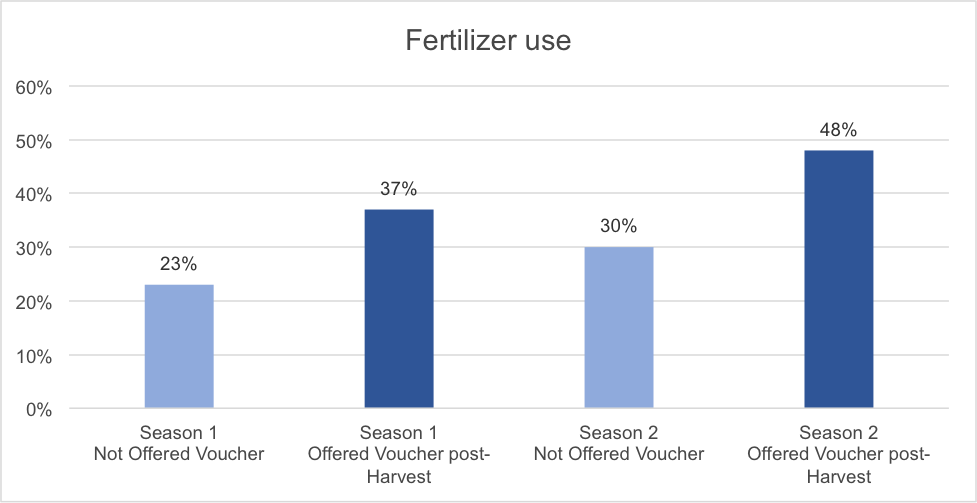
Selling Fertilizer Soon After Harvest Can Increase Use
Organization : Innovations for Poverty Action
Project Overview
Project Summary
Soon after the harvest, farmers can buy a voucher for fertilizer at its usual price, which an NGO will deliver for free later in the season.
Impact
There was a 14-18 percentage point increase in fertilizer use (on a base of 23-30%).
Challenge
Fertilizer has the potential to be a highly profitable investment for farmers in Sub-Saharan Africa because of its capability to increase crop yields. However, few farmers use fertilizer (for example, only 40 percent in the Busia region of Kenya where this project took place); when asked why, many farmers report that they do not have enough money. Yet, even very poor farmers could potentially purchase small amounts of fertilizer—and they may plan to, but then fail to follow through on those plans.
Specifically, right after the harvest, many farmers have enough cash to buy fertilizer. Buying it, however, imposes a small cost (a 30-minute walk, for example, or a transportation fee). Because of this inconvenience and expense, farmers postpone the purchase, believing that they will buy fertilizer later (when it is time to plant), thereby overestimating their ability to put aside the necessary cash. When the time comes to buy fertilizer, they no longer have the money they need to do so. What they lack is a way to set aside money for fertilizer at the time that they have cash.
Design
In order to allow farmers to buy fertilizer at the time when they had enough cash to do so—rather than having to wait until planting, when they may have run out—an officer from the NGO ICS (Investing in Children and their Societies) visited farmers soon after the harvest. The officer offered to sell the farmer a voucher for fertilizer at its usual price, which ICS would deliver for free later in the season, when the need for fertilizer arises.
Impact

A randomized evaluation found that selling farmers a voucher for fertilizer soon after the harvest increased fertilizer usage. In the first season, usage increased by 14 percentage points (on a base of 23%); in the second season, offering the voucher increased usage by 18 percentage points (on a base of 30%). This effect was greater than that of offering free delivery, even with a 50% subsidy on fertilizer, later in the season.
The program was also popular among farmers. In season one, 31% of the farmers who were offered the voucher bought fertilizer through the program, and in season two, 39% of those offered the program participated.
Implementation Guidelines
Inspired to implement this design in your own work? Here are some things to think about before you get started:
- Are the behavioral drivers to the problem you are trying to solve similar to the ones described in the challenge section of this project?
- Is it feasible to adapt the design to address your problem?
- Could there be structural barriers at play that might keep the design from having the desired effect?
- Finally, we encourage you to make sure you monitor, test and take steps to iterate on designs often when either adapting them to a new context or scaling up to make sure they’re effective.
Additionally, consider the following insights from the design’s researcher:
What worked best?
- Timing appears to be the most important part of the program. Later in the season, offering a 50 percent subsidy on fertilizer in addition to free delivery—a more expensive program—increased fertilizer usage by 13 to 14 percentage points (on a base of 30 percent); this was less than the 18 percentage point increase in usage due to the full-priced voucher sold directly after the harvest.
- Farmers who were offered the program in one season did not buy fertilizer in subsequent seasons (as we would expect if farmers were learning about fertilizer through the program). This suggests that procrastination is the barrier to fertilizer use in this context, and that the commitment device the program offers is what farmers need.
Would this work elsewhere?
- This study contributes to a body of evidence indicating that commitment devices, education, and appropriate timing of these interventions can increase farmers’ use of fertilizer.
- Aiding in effective implementation of this project was the fact that International Child Support (ICS)-Africa has had a long-lasting presence in Western Kenya; farmers know and respect ICS.
- In this context, fertilizer was available in small quantities at market centers (and occasionally in local shops outside of market centers). A rough estimate was that the typical farmer needed to walk for roughly 30 minutes to reach the nearest market center.
Costs you are likely to encounter include:
- Cost of delivery
- Cost of visiting farmers
For more guidance on implementing this design, select “I want to try this” from the left drop-down menu.
Project Credits
Researchers:
Esther Duflo Contact Massachusetts Institute of Technology
Michael Kremer Harvard University
Jonathan Robinson University of California, Santa Cruz


